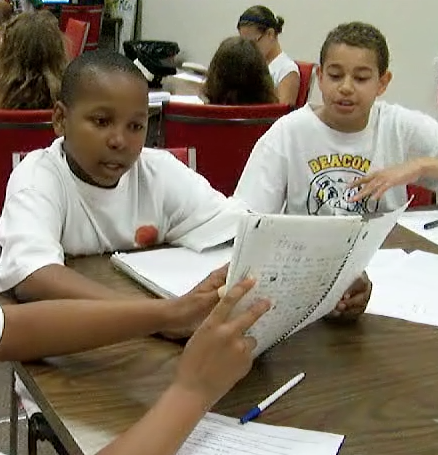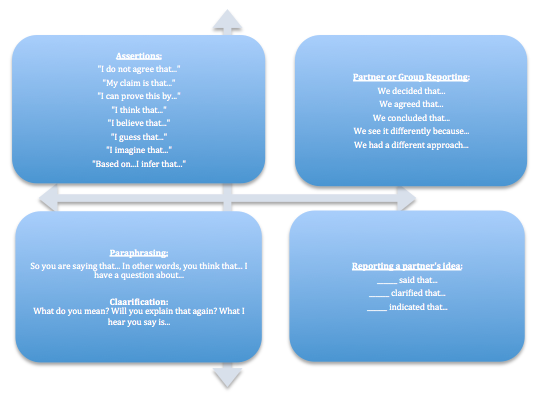Structured Discussions: Best Practices
insert
1. Engaging Our Students In and Through Discussions
How do we engage our students in, and through, discussion?
General Engagement Strategies
Student class discussions, peer discussions, group discussions, vocabulary teaching and pre-teaching - these are all scaffolding tools that aid students in getting from Point A, to Point B. Here are some scaffolding techniques that make nice "scaffolding essentials":
Partner Responses: Each student is assigned a partner to share, compare, rehearse, brainstorm, or review key content at various junctures throughout the lesson.
Choral Responses: Students are prompted to practice using new words, phrases, and terms chorally to aid each other in pronouncing words syllable-by-syllable. These can also involve quick checks, such as placing a finger under the first word in a paragraph, or tracing while speaking, signaling a thumbs up for agreement or other hand signals to communicate a response.
Communicative Language Functions: Students select from a range of taught strategies to participate in classroom discourse with. Such functions include: asking questions when confused, using academic vocabulary intentionally such as in formal discussions. Practice these functions with students, allow them opportunities to share with peers, and hold them accountable for active listening by calling on them on-the-spot to either complete a sentence, finish a reading passage, or answer a question.
After teaching students how to respond to, and with, language prompts, keep them posted throughout the room for quick and constant reference. You'll find that students use them more often, and thus retain information longer. Here are some examples of placement prompts:
Sentence Frames and Sentence Starters: Sentence starters give students the beginning of a written or oral response, and they finish it on their own. For example: “One critical attribute of the character is ...." or "I think ____'s most important character trait is...” Sentence starters facilitate academic discussions.
Participation: Many students will not participate in class or group discussions, even when trained and rehearsed. Often the same students speak time and time again. Carefully structure each phase of the discussion to insure every student is prepared to contribute. Support all students in their contributions, and hold them accountable for their active contributions.
Key Principles for Structuring Academic Discussions
- Provide a focus question: How do you gain respect from your peers? What is meant by "prepare for the worst"?
- Pre-teach the vocabulary
- Frame the question so that all students understand it, and can respond to it.
Examples:
- Pre-reading discussion to prepare student for understanding of text, fiction or non-fiction
- Model examples to get students started: “Copy my example of being a good listener, then list as many additional ways you earn respect from your peers as you can in the next 5 minutes.
- Provide sentence starters to frame ideas and prompt students into an academic response.
- Build newly taught academic vocabulary into sentence starters.
- Monitor student progress and offer them ample, often additional, time as needed to fully participate in the discussion.
- Have students use new vocabulary in their discussions, or offer additional points to do so.
- Circulate the room to facilitate discussions, prompt, and generally oversee their movement toward learning targets, objectives, and use of the assigned protocols.
- Call on students randomly to invoke full participation from all.
- Remind students to use their "lunch room voice" or "public voice" for appropriate group discourse as needed.
- Encourage their use of academic vocabulary when appropriate and relevant.
- Always provide a focus question.
